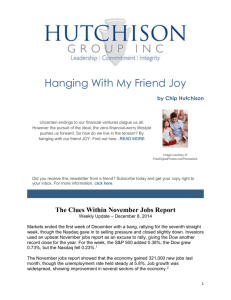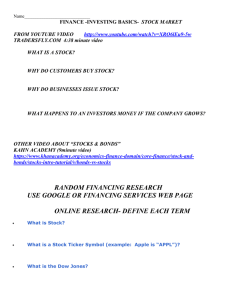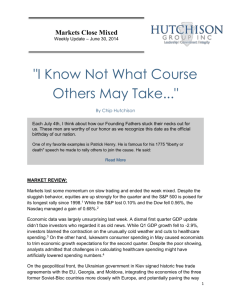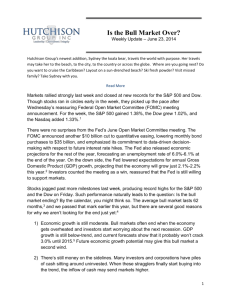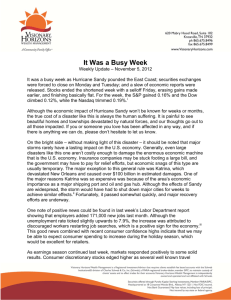Word Document - Hutchison Group
advertisement
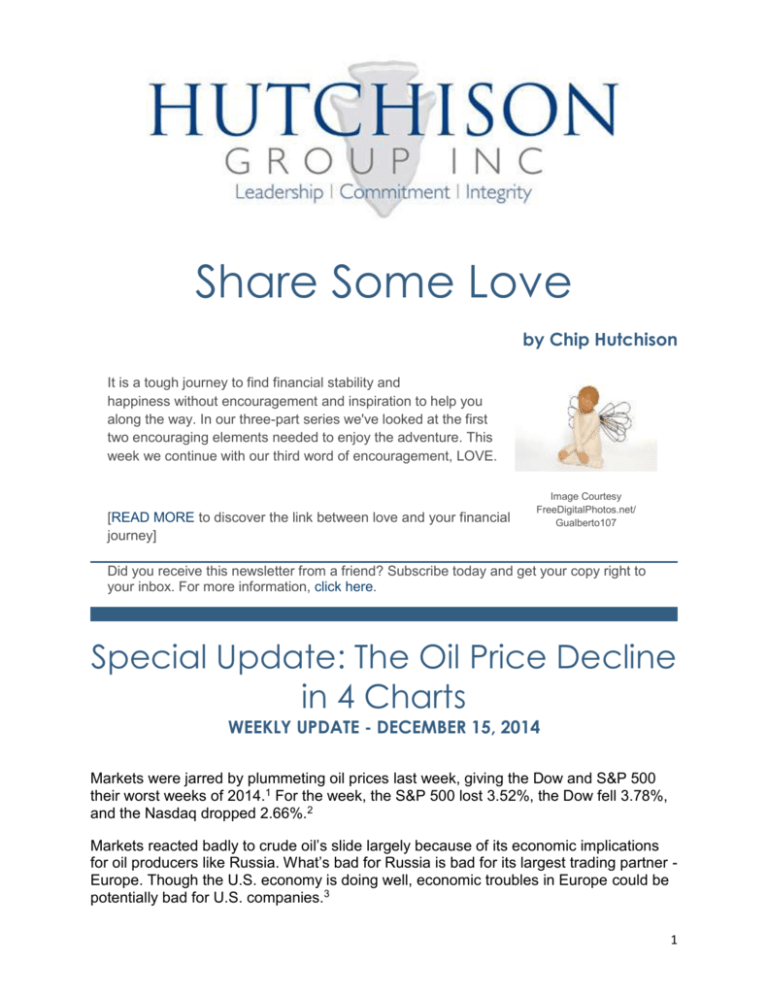
Share Some Love by Chip Hutchison It is a tough journey to find financial stability and happiness without encouragement and inspiration to help you along the way. In our three-part series we've looked at the first two encouraging elements needed to enjoy the adventure. This week we continue with our third word of encouragement, LOVE. [READ MORE to discover the link between love and your financial journey] Image Courtesy FreeDigitalPhotos.net/ Gualberto107 Did you receive this newsletter from a friend? Subscribe today and get your copy right to your inbox. For more information, click here. Special Update: The Oil Price Decline in 4 Charts WEEKLY UPDATE - DECEMBER 15, 2014 Markets were jarred by plummeting oil prices last week, giving the Dow and S&P 500 their worst weeks of 2014.1 For the week, the S&P 500 lost 3.52%, the Dow fell 3.78%, and the Nasdaq dropped 2.66%.2 Markets reacted badly to crude oil’s slide largely because of its economic implications for oil producers like Russia. What’s bad for Russia is bad for its largest trading partner Europe. Though the U.S. economy is doing well, economic troubles in Europe could be potentially bad for U.S. companies.3 1 Though it can be depressing to experience a market drop so close to the end of the year, there may be a silver lining to oil’s decline. In this week’s update, we’re taking a look at some of the short- and long-term factors behind the drop in oil prices. Since June, the price of Brent crude, one of the most commonly used crude oils, has fallen from a high of $115.19 to the current low of $65.64.4 Oil Prices Have Declined 43% Since June Europe Brent Crude Spot Price USD$/bbl $120 $110 $100 $90 $65.64 December 8, 2014 $115.19 June 19, 2014 $80 $70 $60 06/02/14 07/02/14 08/02/14 09/02/14 10/02/14 11/02/14 12/02/14 Source: Energy Information Administration In the short term, the rise of the United States as an oil-producing power has pushed up global oil supplies, thus depressing oil prices. Millions of barrels, daily Shale Projects Have Caused U.S Oil Production to Soar 10.5 M 10.0 M 9.5 M 9.0 M 8.5 M 8.0 M 7.5 M 7.0 M 6.5 M 6.0 M 10 million barrels per day 6.8 million barrels per day 2003 2004 2005 2006 2007 2008 +47.5% 2009 2010 2011 2012 2013 Source: BP Statistical Review of World Energy In November, the Organization of the Petroleum Exporting Countries (OPEC), an international group that coordinates oil production between members to stabilize prices, met to determine production quotas. While the group, whose members control 40% of global oil supplies, could have acted to reduce the oil glut by cutting production, they 2 voted to maintain current production levels, sending oil prices even lower.5 While it may seem crazy, it’s likely that OPEC members are seeking to drive smaller producers out of the market. On the other side of the equation, economic growth in many major oil markets is stalling, reducing the demand for oil. Developed countries have also made major strides in reducing energy use and increasing efficiency. All this spells declining demand in many markets. Global oil consumption estimates have been cut four times this year as the oil industry struggles to come to grips with changing fundamentals.6 Millions of Barrels, Daily Oil Consumption in Developed Nations is Declining 52.0 M 47.0 M 42.0 M 37.0 M 32.0 M 2005 2006 2007 2008 Developed (OECD) Economies 2009 2010 2011 2012 2013 Emerging (Non-OECD) Economies Source: BP Statistical Review of World Energy Other long-term factors may affect future oil demand. Economists predict that U.S. gasoline consumption will flatten and contract in coming years.7 Demographic trends in the U.S. suggest that domestic demand may fall as baby boomers retire and reduce their driving; Millennials, members of the largest generation in U.S. history, are moving to cities and using alternative transportation in increasing numbers. Use of renewable energy sources is also on the rise and expected to continue, though cheap oil may make alternative energy less fiscally appealing. What does cheap oil mean for the U.S.? On the positive side, lower prices will likely boost consumer sentiment and increase discretionary spending, which is great news for U.S. businesses. Based on U.S. Highway Administration estimates, this year’s gas price drop has translated into over $1,000 in annual savings for the average American household.8 On the other hand, the U.S. is becoming a serious oil producer and low prices are bad news for domestic oil producers. The economic viability of U.S. shale oil production (the source of its recent oil boom) relies on high oil prices to offset expensive extraction. One metric used by energy analysts is the “breakeven price,” which is the oil price needed for projects (or producers) to make a healthy return. Can shale oil producers survive in a world of dirt-cheap oil? Opinions differ; the chart below shows the estimated breakeven price for several shale oil projects. 3 Est. Fiscal Breakeven Oil Prices Market Price Needed to Balance Budgets in 2014 Current Oil Price BG Marcellus Shale Saudi Arabia Russia COP Bakken Shale $45 $65 Iran Venezuela Iraq $85 $105 $125 $145 $165 Brent Crude (USD$/bbl) Source: Business Insider, Deutsche Bank Research, Wall Street Journal, Citibank Research While some projects may be able to survive low oil prices, one estimate puts the average breakeven price of U.S. shale projects around $65-$70/barrel, indicating that many are vulnerable to low oil prices.9 Globally, oil price instability and continued downward pressure could mean bad news for major producers like Saudi Arabia and Russia that depend on oil revenues to make debt payments. While some countries have large cash reserves that will help cushion the effects of cheap oil, the long-term economic effects could be serious. Bottom line: How Low Can Oil Go? Well, that’s the trillion-dollar question and everyone has a guess. Government energy economists are currently forecasting an average price of $68/barrel on Brent Crude, though they admit there’s a great deal of uncertainty in price forecasts right now.10 Are oil and gasoline prices going to remain this low? Hard to know. The prices we are seeing are partially the result of speculation and bearish sentiment on oil. While fundamentals suggest oil prices will remain depressed in 2015, it’s unlikely that $2.00 gas is here to stay.11 Let’s make the most of it while we can. Looking ahead, we can expect additional market volatility as traders take a look at their portfolios after last week’s rout. Wednesday’s Federal Reserve Open Market Committee meeting will also be in focus; analysts hope that the Fed will address how the recent drop in oil prices may affect the timing of future interest rate increases. ECONOMIC CALENDAR: Monday: Empire State Mfg. Survey, Industrial Production, Housing Market Index Tuesday: Housing Starts, PMI Manufacturing Index Flash Wednesday: Consumer Price Index, EIA Petroleum Status Report, FOMC Meeting Announcement, FOMC Forecasts, Chair Press Conference 2:30pm Thursday: Jobless Claims, Philadelphia Fed Survey 4 Data as of 12/12/2014 1-Week Since 1/1/14 1-Year 5-Year 10-Year Standard & Poor's 500 -3.52% 8.33% 12.78% 16.20% 6.85% DOW -3.78% 4.25% 9.79% 13.01% 6.39% NASDAQ -2.66% 11.42% 16.39% 22.49% 11.87% U.S. Corporate Bond Index 0.87% 4.14% 4.31% 2.18% 0.93% International -3.55% -7.75% -3.04% 2.48% 2.08% Data as 12/12/2014 1 mo. 6 mo. 1 yr. 5 yr. 10 yr. Treasury Yields (CMT) 0.02% 0.09% 0.19% 1.53% 2.10% Notes: All index returns exclude reinvested dividends, and the 5-year and 10-year returns are annualized. Sources: Yahoo! Finance and Treasury.gov. International performance is represented by the MSCI EAFE Index. Corporate bond performance is represented by the DJCBP. Past performance is no guarantee of future results. Indices are unmanaged and cannot be invested into directly. HEADLINES: Congress passes $1.1 trillion spending bill. After weeks of closed-door haggling and bitter partisanship, Congress passed a budget bill, funding most government agencies through September 2015 and avoiding a government shutdown. 12 Retailers bounce back from Black Friday. Despite a slow Thanksgiving shopping period, new data shows that November sales increased by 5.4% over last year for brickand-mortar stores.13 China’s economy may slide to 7.1% growth in 2015. The Chinese central bank announced that a slack domestic real estate sector could cause China to miss growth forecasts. Though China’s export sector is still growing, it’s not enough to offset the weak property sector.14 Weekly jobless claims fall. Initial claims for state unemployment benefits fell again, though continuing claims increased. The four-week moving average edged upward, though it remained below 300,000 for the 13th straight month. “If I had six hours to chop down a tree, I’d spend the first four hours sharpening the axe.” – Abraham Lincoln 5 Tiramisu Tiramisu is a luxurious no-bake dessert that’s perfect for a dinner party. Serves 4-6 Ingredients: 1 tablespoon sugar 1/2 cup espresso or dark coffee 1 tablespoon dark liquor (such as dark rum, brandy, bourbon, or Frangelico) 14 ladyfinger cookies 32 oz. (2 pints) vanilla ice cream or mascarpone (add 1 extra tablespoon of sugar for the mascarpone) 2 tablespoons cocoa powder Directions: 1. While the coffee or espresso is still warm, whisk the sugar in until it dissolves. Add the liquor and chill. Pour the mixture into a baking dish and dip each ladyfinger quickly, shaking off excess liquid. Line the bottom of an 8x8 baking dish with the ladyfingers, pressing them together and trimming to fit. 2. Beat the vanilla ice cream or sweetened mascarpone with an electric mixer until it’s soft and spreadable. Pour the mixture over the ladyfingers and use a spatula to spread it over the whole dish. 3. Cover with plastic wrap and freeze 2 hours until firm or overnight. 4. Remove it from the freezer about 20 minutes before serving to soften. Dust the top with cocoa powder before serving. 6 Recipe adapted from Sara Quessenberry | RealSimple.com15 Year-End IRA Reminders With the end of the year approaching, take a moment to make sure you’ve taken care of your Individual Retirement Accounts: Contribute the maximum. In 2014, you can contribute a maximum of $5,500 or $6,500 if you are age 50 or over. Remember, you have to have taxable income to contribute to an IRA, but if you are married and filing jointly, you can each make contributions even if only one of you is working. Speak to a tax advisor to learn about how your deductions will be affected by an employer-sponsored retirement plan. Don’t contribute more than the max. If you contribute more than the IRA limits for 2014 (or more than your income allows you to contribute), you will be subject to a 6% tax on the excess contribution amount for each tax year the money remains in your account. You can withdraw excess contributions by the due date for your tax return. Take your RMD. If you are at least age 70½, you are required to take minimum distributions from your traditional IRA – but not your Roth. You are generally required to take RMDs by December 31, though you have until April 15, 2015 if you turned 70½ in 2014. Though you received RMD notices for each of your IRAs, you can take the total annual amount from a single IRA. Remember – the IRS will levy a 50% excise tax on any undistributed RMD. For more information about IRAs or end-of-year tax planning, please call us or another qualified tax advisor. Tip courtesy of IRS.gov16 Choose the Right Club Most amateur golfers choose the club they play based on the length of the shot. They play shorter clubs for shorter distances and longer clubs for longer distances. However, experienced golfers know that factors like natural swing tendencies, wind, lie, and 7 hazards also affect your club choice. Before choosing a club, ask yourself these questions: What’s the distance to the hole? What personal quirks affect my shot? How will the wind affect the shot? What hazards do I need to watch out for? What does the landing area look like? What is the follow-up shot? Tip courtesy of Barry Goldstein | Golf Tips Mag17 Reduce Acid Reflux With Simple Lifestyle Changes Acid reflux, commonly known as heart burn, affects millions of Americans. Though smokers and the overweight are more prone to heartburn, it can strike anyone. However, there are some simple changes that can help you prevent the issue: Gastroenterologists say that sleeping on a wedge pillow can help prevent nighttime attacks by elevating your upper body. Avoid acidic foods and drinks like soda, alcohol, coffee, tomatoes, and citrus. Cut down on fatty and fried foods. Stop eating before bed so that you can give your stomach time to digest – two or three hours is best. Tip courtesy of AARP18 Seal Your Windows Windows and doors can be major sources of heat loss in your home and can run up your heating bill if left unaddressed. Seal uninsulated windows in out-of-the-way places with bubble wrap by misting the pane with water and pressing the bubble side against the glass. Find leaky windows and doors in your house by closing all access points to the house and shutting off any central heating or air. Light an incense taper near external windows 8 and doors and watch the smoke. If the smoke moves instead of drifting upward, you have a leak. Tip courtesy of AARP19 Share the Wealth of Knowledge! Please share this market update with family, friends, or colleagues. If you would like us to add them to our list, simply click on the "Forward email" link below. We love being introduced! If you would like to opt-out of future emails, please reply to this email with UNSUBSCRIBE in the subject line. Insert your broker/dealer disclosures here. i.e. Securities offered through “Your B/D Name Here,” Member FINRA/SIPC. Investing involves risk including the potential loss of principal. No investment strategy can guarantee a profit or protect against loss in periods of declining values. Diversification does not guarantee profit nor is it guaranteed to protect assets. The Standard & Poor's 500 (S&P 500) is an unmanaged group of securities considered to be representative of the stock market in general. The Dow Jones Industrial Average is a price-weighted average of 30 significant stocks traded on the New York Stock Exchange and the NASDAQ. The DJIA was invented by Charles Dow back in 1896. The Nasdaq Composite is an index of the common stocks and similar securities listed on the NASDAQ stock market and is considered a broad indicator of the performance of stocks of technology companies and growth companies. The MSCI EAFE Index was created by Morgan Stanley Capital International (MSCI) that serves as a benchmark of the performance in major international equity markets as represented by 21 major MSCI indexes from Europe, Australia and Southeast Asia. The Dow Jones Corporate Bond Index is a 96-bond index designed to represent the market performance, on a total-return basis, of investment-grade bonds issued by leading U.S. companies. Bonds are equally weighted by maturity cell, industry sector, and the overall index. The S&P/Case-Shiller Home Price Indices are the leading measures of U.S. residential real estate prices, tracking changes in the value of residential real estate. The index is made up of measures of real estate prices in 20 cities and weighted to produce the index. The 10-year Treasury Note represents debt owed by the United States Treasury to the public. Since the U.S. Government is seen as a risk-free borrower, investors use the 10-year Treasury Note as a benchmark for the long-term bond market. Google Finance is the source for any reference to the performance of an index between two specific periods. Opinions expressed are subject to change without notice and are not intended as investment advice or to predict future performance. Past performance does not guarantee future results. You cannot invest directly in an index. Consult your financial professional before making any investment decision. Fixed income investments are subject to various risks including changes in interest rates, credit quality, inflation risk, market valuations, prepayments, corporate events, tax ramifications and other factors. These are the views of Platinum Advisor Marketing Strategies, LLC, and not necessarily those of the named representative, Broker dealer or Investment Advisor, and should not be construed as investment advice. Neither the named representative 9 nor the named Broker dealer or Investment Advisor gives tax or legal advice. All information is believed to be from reliable sources; however, we make no representation as to its completeness or accuracy. Please consult your financial advisor for further information. By clicking on these links, you will leave our server, as they are located on another server. We have not independently verified the information available through this link. The link is provided to you as a matter of interest. Please click on the links below to leave and proceed to the selected site. 1 http://www.cnbc.com/id/102263988 2 https://www.google.com/finance?q=INDEXDJX%3A.DJI%2CINDEXSP%3A.INX%2CINDEXNASDAQ%3A.IXIC&ei=pteNVN HTE9Hf8wacs4BQ 3 http://www.cnbc.com/id/102263988 4 http://www.eia.gov/dnav/pet/pet_pri_spt_s1_d.htm 5 http://uk.businessinsider.com/opec-votes-not-to-cut-production-oil-prices-plummet-2014-11 6 http://www.bloomberg.com/news/2014-12-12/iea-cuts-global-oil-demand-forecast-for-4th-time-in-five-months.html 7 http://www.bloomberg.com/graphics/2014-america-shakes-off-oil-addiction/ 8 http://www.bloomberg.com/news/2014-10-16/shale-boom-helping-american-consumers-like-never-before.html Calculation assumes average annual consumption of 1,000 gallons of gasoline. Peak average gas price of $3.788/gal (EIA weekly average 4/28/14) and $2.600/gal (AAA daily average 12/12/14). 9 http://www.economist.com/news/finance-and-economics/21635505-will-falling-oil-prices-curb-americas-shale-boom-bind 10 http://www.eia.gov/forecasts/steo/report/prices.cfm 11 http://www.eia.gov/forecasts/steo/report/prices.cfm 12 http://www.cnbc.com/id/102266535 13 http://www.cnbc.com/id/102254146 14 http://www.cnbc.com/id/102266550?trknav=homestack:topnews:7 15 http://www.realsimple.com/food-recipes/browse-all-recipes/tiramisu 16 http://www.irs.gov/uac/Top-Four-Year-End-IRA-Reminders 17 http://www.golftipsmag.com/instruction/shotmaking/quick-tips/8-tricks-to-become-a-better-player.html#.VI2uzmTF-pw 18 http://blog.aarp.org/2014/12/08/7-ways-to-reduce-acid-reflux-even-if-youre-the-president/ 19 http://www.aarp.org/money/budgeting-saving/info-2014/winter-savings-tips-photo.html#slide5 10
